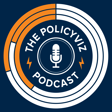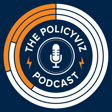
Exploring the Unbound Realms of Information Design with Sheila Pontis & Michael Babwahsingh
Happy New Year and welcome back to the PolicyViz Podcast! In this first episode of 2024, I welcome welcome Sheila Pontis and Michael Babwahsingh, authors of the new book Information Design Unbound. They delve into the heart of information design, sharing their experiences in creating a pivotal resource for both students and professionals. This episode is a must-listen for anyone interested in the ever-evolving world of design thinking and information conveyance.
Topics Discussed
- Origins of “Information Design Unbound”: Sheila and Michael discuss their drive to pen a comprehensive guide in the field of information design, recognizing the gap in educational resources for this burgeoning discipline.
- Collaborative Challenges: The duo sheds light on the difficulties they faced while integrating varied viewpoints and adhering to publishing constraints and deadlines.
- Educational Resource: With over 400 images and contributions from more than 65 experts, the book is a treasure trove of knowledge, featuring exercises and activities aimed at both new learners and seasoned practitioners.
- Design Education for Non-Designers: The authors emphasize the importance of teaching design and information design to students without a formal background in design, tailoring approaches based on the students’ areas of study.
- Professional Team Dynamics: An exploration into the various team structures within the field of information design and how they collaborate to address complex issues.
- Evolution of Design Thinking: A shift from creating traditional design artifacts to solving complex systems and wicked problems is discussed, marking the advancement in design methodologies.
- Cultural Sensitivity in Design: The conversation highlights the crucial role of context, audience, and cultural differences when employing icons and other design elements, acknowledging that design solutions are not universally applicable.
➡️ Check out more links, notes, transcript, and more at the PolicyViz website.
Sponsor: Whisper Transcribe
Whisper Transcribeis a transcription game-changer! It turns a three-hour video into accurate, well-punctuated text in just 8 minutes, saving hours of work. Not only does it transcribe audio and video, but the underlying AI model will generate sample summaries, social media content, bullet points, and more. Check it out!

